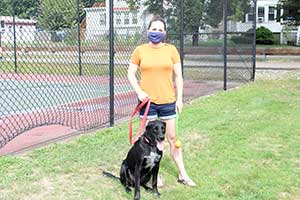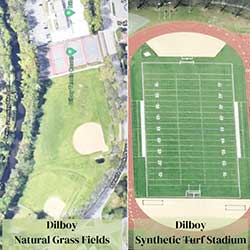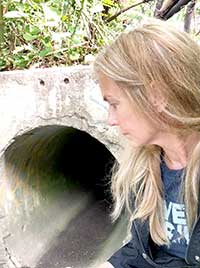
The natural grass fields have been hard-packed over years of use and when it rains water “sheet flows” into Alewife Brook and causes pooling on the fields. Residents, like Erin Turco, as well as athletes, should see a difference with the new drainage system. — Photo by Denise Keniston
By Denise Keniston
tw:@denisekeniston
West Somerville resident Erin Turco walks her dog Wally most days and when it isn’t raining, she heads to the Dilboy Stadium and Fields complex. Because of limited recreation space in Somerville, natural grass athletic fields often double as recreation spaces for residents like Turco. “These fields are disgusting!” says Turco. “They are especially gross in the spring and fall. When it rains there’s mud, muck, and the rain forms pools of standing water which attracts bugs.”
Phase One: The Dilboy Synthetic Turf Stadium and Track
The Dilboy Stadium and Fields Renovation Project falls under Somerville’s “Fields Master Plan.” The site design includes two phases: Dilboy Stadium and the natural grass auxiliary fields. “The fields, stadium, and track are unusable when it rains,” says Arn Franzen, Somerville’s Director of Parks. “These renovations will ensure the safety of athletes using the fields for football, soccer, softball, and other activities. These updates are long overdue.”

The Dilboy Renovation Project consists of two phases; the Stadium and the auxiliary fields. The AstroTurf carpet on the Stadium field will be replaced and restriped, and the “crumb rubber” infill replaced with a new plant-based infill cushion. The natural grass fields will get new drainage and sports field lighting. The entire complex abuts Alewife Brook which is protected wetlands.
The Dilboy Stadium plan focuses on resurfacing the turf field and track. Athletes will see and feel a change in the infill that’s used as cushioning under the synthetic top layer. A new wood-based infill will replace the current “crumb rubber” infill made from old tires.
Ward 7 Councilor Katjana Ballantyne has “seen crumb rubber floating in the Alewife Brook” and at a recent meeting wanted assurances that any of the new wood-based infill “will be captured by the new fine mesh screens being inserted in the drainage system.”
Site designer David Warner, President of Warner Larson Landscape Architects, says, “We’re not anticipating a lot of material being moved off the field [by rain or flooding]. BrockFILL [the new wood-based infill] adsorbs water and will stay in place,” he says. “Unless it’s tracked off the field by athletes.”
Phase Two: Auxiliary Natural Grass Fields Improvements
Renovations to the natural grass fields will be more extensive. The fields will be dug up and “sand slits” (a network of drainage trenches and pipes) will be installed to build a more permeable playing surface. Site designer David Warner says, “That’s giving it more surface area for infiltration and absorption so that the nutrients that are applied to the natural grass are going to be absorbed into the soil, root system, plants rather than running off the surface in a rainstorm.”

Rainwater from the new ‘sand-slit’ drainage system will tie into this 36” culvert that runs under the buffer zone and deposits directly into Alewife Brook. The runoff from the fields will be reduced with fewer particulates and less unused nutrients.
A 25-ft buffer zone between the outfields and Alewife Brook will be established that meets the requirements of the Wetlands Protection Act. The plan calls for the removal of invasive species, such as Japanese knotweed, and replanting of a fourteen-plant native mix that includes Butterfly Milkweed and Switchgrass. Both the natural grass and native plants will receive a non-phosphorous fertilization protocol.
Patrick Herron, Executive Director Mystic River Waterway Association, says, “The city of Somerville deserves credit for being thoughtful’ on the project. However, “over-fertilization” up and down the brook is a problem. He adds, “The whole watershed, including the Mystic River and Alewife Brook, are receiving too much nutrient pollution and to reach a healthy level where aquatic life is not impacted, we would need to reduce nutrients in the whole watershed by 60% and the efforts to do that will require decades. It calls out the need for bringing that problem to the level of parcels when being redeveloped. We have an opportunity to improve stormwater and reduce nutrients at each site and when those improvements can be coupled with other benefits, as in this case [Dilboy], we can achieve those improvements in a cost-effective way.”
The fields will get new state-of-the-art LED lighting which will extend the usage of the natural grass fields dramatically. Each light will be 80 feet high and provide targeted light. Also, the dugouts and bleachers will be modified and made handicapped accessible. “This is a great project,” says Arn Franzen, Director of Parks. “We’re looking forward to our final approvals and getting started.”
The project needs final approval from the Somerville Conservation Commission and the Massachusetts Department of Conservation and Recreation. Once approved the project must be funded. Construction on the Dilboy Stadium is expected in the Spring of 2021.















Reader Comments